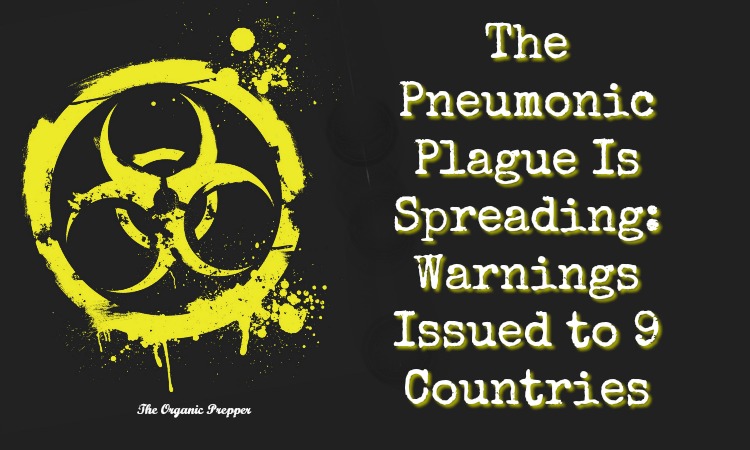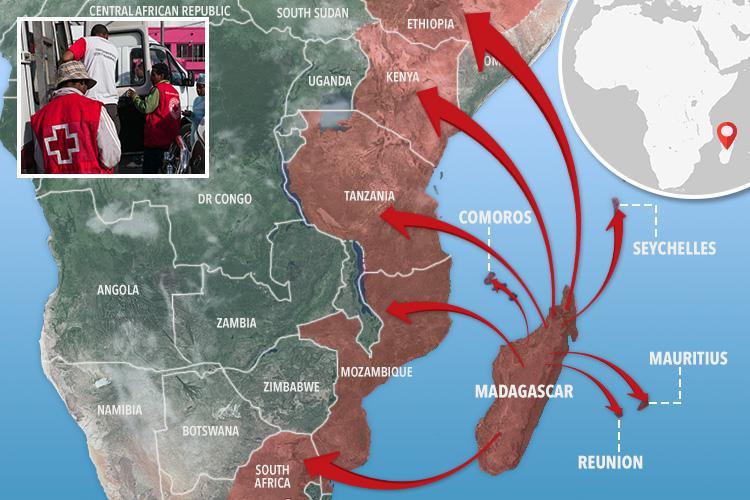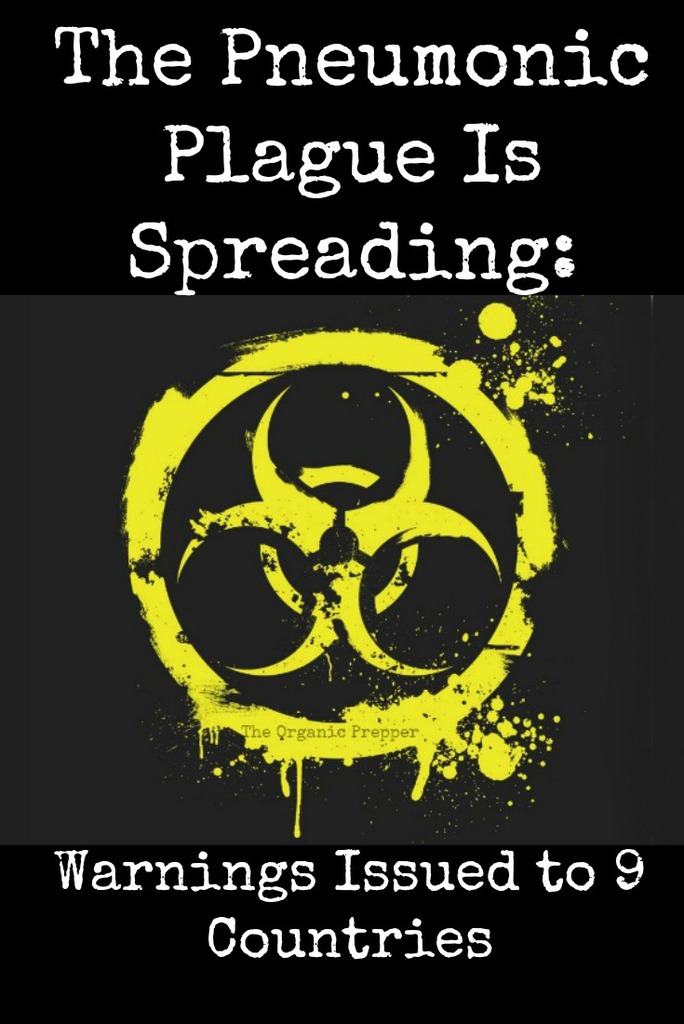If you're new here, you may want to subscribe to my RSS feed. Thanks for visiting!
By Daisy Luther
Madagascar isn’t getting this epidemic of the pneumonic plague under control as everyone had hoped. In fact, the opposite seems to be true.
When I wrote about the plague less than two weeks ago, I cited a source that said there were 200 infections and 33 deaths. As of today, those numbers have increased dramatically to more than 1300 infections and 124 deaths. And according to many infectious disease experts, the outbreak has not yet reached its peak. It’s urgent that we stay up-to-date on this epidemic so that we can be prepared if it goes worldwide. (Sign up here to receive a daily update on the topics important to preppers and follow me here for all the most important news links..)
Normally, Madagascar has about 400 cases of plague per year. But this year, it’s worse because it is the pneumonic plague. It gets into the victim’s lungs and is passed through the air from coughing. It’s the most deadly form of a horrific disease, often killing the victim within 24 hours.
Madagascar is a highly populated island with more than 25 million people, and this outbreak has hit the capital city, with more than a million people crammed into an urban environment. There are no real travel restrictions, so flights are going in and out of the international airport, and cargo is still being shipped. Even worse, the funeral customs in Madagascar have people parading corpses down the street and literally dancing around them.
This has led the World Health Organization to issue an international plague warning and to establish response teams in several countries:
Nine countries and overseas territories have been identified as priority countries in the African region for plague preparedness and readiness by virtue of having trade and travel links to Madagascar.
WHO is prepositioning equipment and supplies, including personal protective equipment, antibiotics and other equipment required to safely identify plague cases, in Comoros, Mauritius, Mozambique, Seychelles, and Tanzania.
Due to the increased risk of further spread and the severe nature of the disease, the overall risk at the national level is considered very high. The risk of regional spread is moderate due to the occurrence of frequent travel by air and sea to neighbouring Indian Ocean islands and other southern and east African countries, and the observation of a limited number of cases in travellers. (source)
Another report tells us:
The risk of regional spread is moderate due to the occurrence of frequent travel by air and sea to neighbouring Indian Ocean islands and other southern and east African countries.
Nine countries and overseas territories have been identified as priority countries in the African region for plague preparedness and readiness by virtue of having trade and travel links to Madagascar.
These countries and overseas territories include Comoros, Ethiopia, Kenya, Mauritius, Mozambique, La Réunion (France), Seychelles, South Africa, and Tanzania. (source)
Some of those locations are holiday hotspots and people would be well-advised to consider other vacation plans.
(photo source)
What are the facts about the pneumonic plague?
Here’s what the CDC has to say about the pneumonic plague:
Pneumonic plague may develop from inhaling infectious droplets or may develop from untreated bubonic or septicemic plague after the bacteria spread to the lungs. The pneumonia may cause respiratory failure and shock. Pneumonic plague is the most serious form of the disease and is the only form of plague that can be spread from person to person (by infectious droplets). (source)
The most apparent symptom of pneumonic plague is coughing up blood. Other symptoms are fever, headache, shortness of breath, chest pain, cough, and sometimes bloody or watery mucous.
Without treatment, the victim will most certainly die.
Pneumonic plague can be treated with antibiotics like streptomycin, gentamicin, tetracyclines, or chloramphenicol but there is a caveat. Treatment MUST begin within 24 hours of the initial symptoms to prevent death. If a person has been exposed to plague, a prophylactic treatment of 7 days of antibiotics can prevent them from becoming ill. Using a close-fitting surgical mask can protect people from contracting plague.
This is the same version of plague known as The Black Death that wiped out a third of the population of Europe during the Middle Ages. With proper intervention, it is unlikely to exact a similar death toll today, but it is still an incredibly dangerous threat.
How do you get prepared for a pneumonic plague pandemic?
First, let me be absolutely clear that at this time, the United States has no cases of plague, nor are Americans at extreme risk. There are no cases of pneumonic plague reported outside Madagascar. However, there are no travel restrictions. Planes and boats are coming and going from the country, so it’s essential to be alert and to watch this carefully. After all, scientists have just warned the world how unprepared we are for a pandemic.
Please remember the almost-catastrophic Ebola pandemic of 2014. It’s essential to prepare for a pandemic well before it ever hits our country because once it arrives, you won’t be able to get the supplies you need in the panic buying frenzy.
If you start to see this epidemic spreading beyond the shores of Madagascar, some common sense preps would not be out of line. Focus on the supplies you need to hunker down and avoid exposure, like a longterm food supply, sanitation supplies, and other items necessary to your family. (You can get a list here.) Be certain to stock up on P100 masks to prevent transmission from an infected person and to prevent inhaling the contagious droplets. If you can’t acquire P100s, get the most protective masks you can get your hands on. (Check out this article for more information on choosing a mask.)
Resources:
- To learn more about preparing for a pandemic, read this.
- This is an awesome book to keep on hand that covers a variety of pandemic scenarios.


















10 Responses
Early symptoms of the plague include fever, weakness, abdominal pain, and chills. The early symptoms could be mistaken for some other virus.
I don’t understand WHY they haven’t suspended flights out of Madagascar.
While the incubation period for some is very short, they can go to bed ok and be dead within 24 hours. For some, the incubation period is up to six days.
One can travel quite a distance in SIX DAYS – with airplanes, cars, ships, etc.
All the more reason why western countries, such as Canada for example should be slowing down 3rd world immigration down to a very controlled trickle – permanently!!!
Another excellent article. May I suggest two books for educational purposes? 1) “Virus X” by Dr. Frank Ryan and 2) ” The Hot Zone”, by Richard Preston. I read them in that order. The first is by a man who studied the very first Ebola outbreak. The second tells how VERY close we came to having an airborne variety of Ebola break out here in America. Very eye opening.
When it comes to incidents like this, can’t a country founded upon the idea of WE THE PEOPLE, i.e the majority, have it’s citizens pressure the government to do something? If you contact your congressman/woman, tell them that you think that the US should issue a travel ban (or travel restrictions) on countries with unfolding pandemics. Take the NRA. They only have around 5 million members, but when those members unite, they can make a big difference. If you are willing to tell your congress representative what you think, you may be able to get them to introduce/vote for a bill on travel to countries with current pandemic. You shouldn’t have to prepare simply because the government won’t. You should be allowed to prepare knowing that the government will do its best before the onus of protection falls onto you. You should tell the government what to do. They are meant to represent you. You have a voice. Use it.
Thanks Daisy for this good and accurate paper; the deadly Black Plague was a mixed form likely and widely spread by rodents. Dont forget closer last century the Mandchurian pneumonic plague, a good demonstration of what can happen. Rather than Ebola, I think to late SARS – MERS events, the most contagious and devastating forms (and it was hard to control in Trtonto as instance). Hopefully, PP is less contagious, and the traffic between Madagascar and other countries is far below of East Asian traffic nowadays (China, Hong Kong etc.). Anyways, this is a reminder of how bad are the hazards in the “global” civilisation of our century, quite different from the 60s-80s of 20th c. I add a comment about personal protection: if good surgical masks (and hygiene) are efficient prophylactic measures, I am horrified by the fact that (after pics-reports), nea rly nobody is able to don and fit the thing properly – not only people of lowest condition but even secretaries working with a Macbook – you can identify the report I mean easily by g…ing- So no efficient protection. A big concern . This is why local education, training, prepping is a mist and its so basic !
Just a quick extra comment about generally prepping for a severe pandemic (or even less severe) – masks (or rather respirators) are efficient only if
– 1) appropriate (you are right for airborne diseases, a N95 or upper grade is a MUST, droplets ask level under)
-2) if correctly donned and worn (must dont know or are unable to stand and keep wearing it for extended time – not touching, breathing and so on)
– 3) eye protection could be a must for some transmissions (air-tight),
– and 4) hand hygiene, change of clothes, transition room are not to be overlooked.
A few tutos, links, pics and information on my FB page, work in progress … (search for Anita Leroy.925)
Good thing Oshitbag isn’t in the White House, he would have a few plane loads of them fly to the U.S. for ‘treatment’ thus exposing us all.
You’re a racist POS, & a complete douche-rocket.
Plague on an island? Sounds like a bio “experiment” release to me. Shades of Plum Island, Fort Detrick (? sp.) and other such bio-warfare projects so mush loved by population control and bio-warfare freaks.
I see where the Church of Jesus Christ of Latter Day Saints that have missionaries all over the world have pulled all missionaries our of Madagascar.